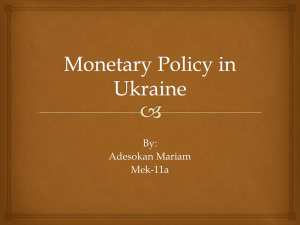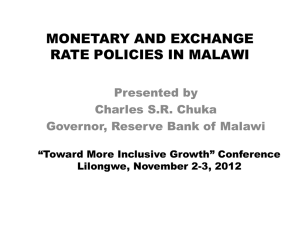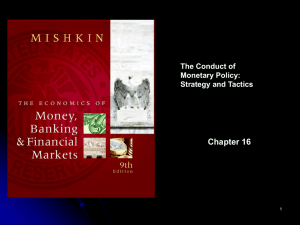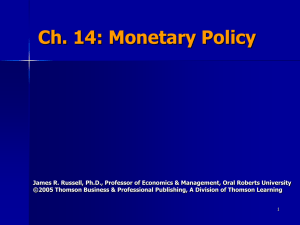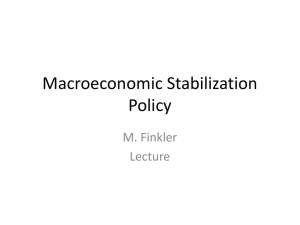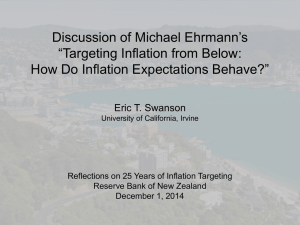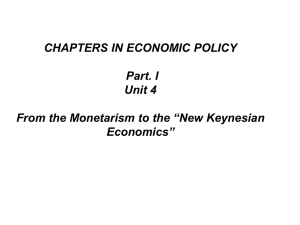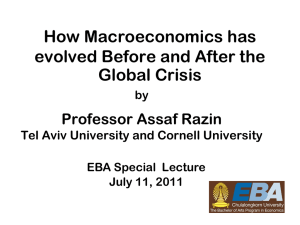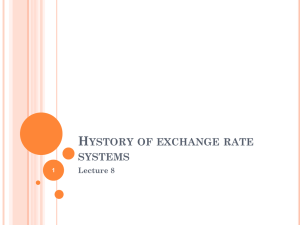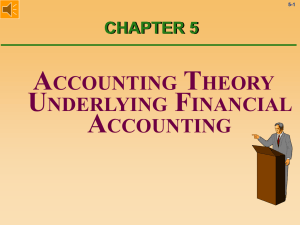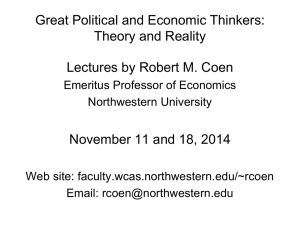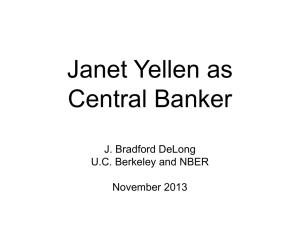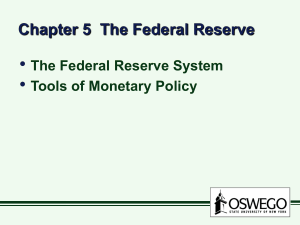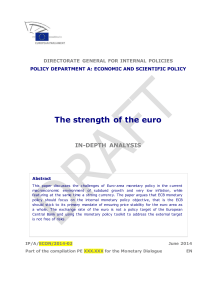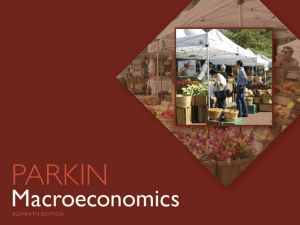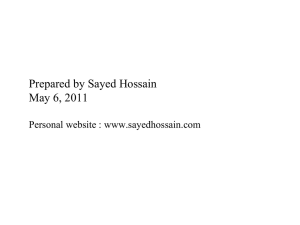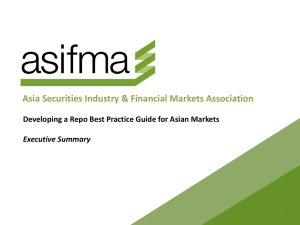Monetary Policy-30.01.2013
advertisement
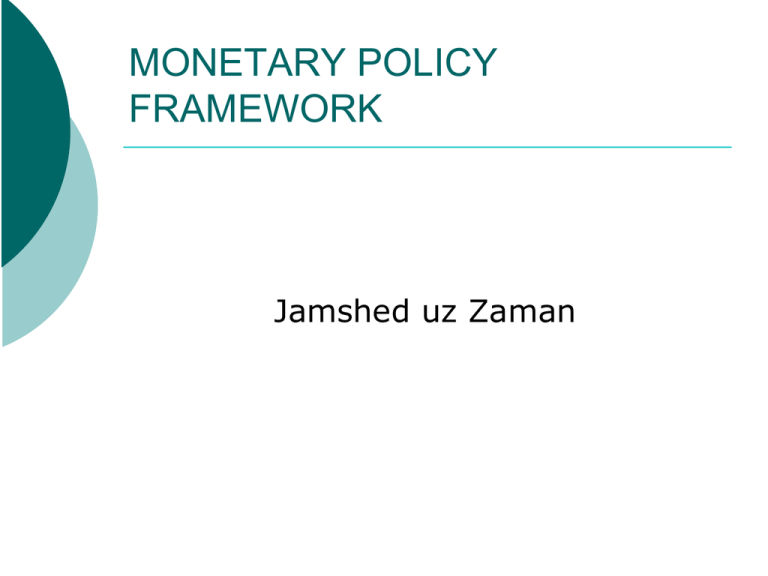
MONETARY POLICY FRAMEWORK Jamshed uz Zaman Major Divisions of the Economy If our economy were a circle then one half of it would be real sector and the other be Financial sector. Economy Real Sector Financial Sector The real sector is dealt with by many ministries, while ministry of finance and central bank deal with the financial sector Economy Ministry of: • Ministry of Finance, Real Sector •Bangladesh Bank Financial Sector •Agriculture, •Industries •Energy and natural resources • Commerce •Communic ations •Water resources Etc. Output of the real sector is GDP(Y) while that of financial sector is money (MV) Interaction between the sectors determine the price level (monetarists concept) Output of the Economy GDP (Y) Money (MV) P When Y P and When MV P MV Y -10 1974-75 1975-76 1976-77 1977-78 1978-79 1979-80 1980-81 1981-82 1982-83 1983-84 1984-85 1985-86 1986-87 1987-88 1988-89 1989-90 1990-91 1991-92 1992-93 1993-94 1994-95 1995-96 1996-97 1997-98 1998-99 1999-00 2000-01 2001-02 2002-03 2003-04 2004-05 2005-06 2006-07 2007-08 2008-09 2009-10 2010-11 Inflation and M2 Growth have some relationship in the Long term 50 M2 Growth Inflation 40 30 20 10 0 In Bangladesh the short term relationship is weak and is not cointegrated. Lag relation may be. 25 14 M2 Growth 12 Inflation (yoy) 20 10 15 8 6 10 4 5 2 ar '0 7 Au g' 07 Ja n' 08 Ju n' 08 No v' 08 Ap r'0 9 M Ju l'0 5 De c'0 5 M ay '06 O ct '0 6 Fe b' 05 0 Ap r'0 4 Se p' 04 Ju n' 03 No v'0 3 0 20 -5 -10 1974-75 1975-76 1976-77 1977-78 1978-79 1979-80 1980-81 1981-82 1982-83 1983-84 1984-85 1985-86 1986-87 1987-88 1988-89 1989-90 1990-91 1991-92 1992-93 1993-94 1994-95 1995-96 1996-97 1997-98 1998-99 1999-00 2000-01 2001-02 2002-03 2003-04 2004-05 2005-06 2006-07 2007-08 2008-09 2009-10 2010-11 GDP is supply side. In crisis year it has serious influence Inflation GDP Growth 15 10 5 0 -5 -10 2009-10 2008-09 2007-08 2006-07 2005-06 2004-05 2003-04 2002-03 2001-02 2000-01 1999-00 1998-99 Inflation 1997-98 1996-97 1995-96 1994-95 1993-94 1992-93 1991-92 1990-91 1989-90 30 1988-89 1987-88 1986-87 1985-86 1984-85 1983-84 1982-83 1981-82 1980-81 Pass-through effects 35 %Growth Import Price 25 20 15 10 5 0 -5 2009-10 2008-09 2007-08 2006-07 2005-06 2004-05 2003-04 2002-03 2001-02 2000-01 1999-00 Inflation 1998-99 1997-98 1996-97 1995-96 1994-95 1993-94 1992-93 1991-92 1990-91 1989-90 1988-89 1987-88 1986-87 1985-86 1984-85 1983-84 1982-83 1981-82 1980-81 Exchange rate is a monetary phenomenon 25 Exchange Rate %Change 20 15 10 5 0 -5 2009-10 2008-09 2007-08 2006-07 2005-06 2004-05 2003-04 2002-03 2001-02 2000-01 1999-00 1998-99 Inflation 1997-98 1996-97 1995-96 1994-95 1993-94 1992-93 1991-92 1990-91 1989-90 20 1988-89 1987-88 1986-87 1985-86 1984-85 1983-84 1982-83 1981-82 1980-81 If any relation, between Indian and Bangladeshi Inflation, it may be the result of the same cause Indian Inflation 15 10 5 0 Results found Looking at these slides it becomes imperative that in long run inflation in Bangladesh is mainly caused by money (??). [Financial deepening, Gini coefficient – poverty situation should also be considered] Can short run monetary policy stabilize inflation? If not, our target of the policy should not be inflation. Targets of Monetary Policy round the globe Inflation targeting (NZ), Interest rate targeting, Exchange rate targeting, Etc. In Bangladesh we target Quantity of Money in accordance to the Government (or projected) targets of GDP growth rate and inflation rate. In targeting quantity of money, how we determine the right quantity of money? y = PY Or, y(1+Δy)=P(1+ΔP) Y(1+ ΔY) Or, Δy=(1+ΔP) (1+ ΔY)-1 Or, ΔM = ξ[(1+ΔP) (1+ ΔY)-1] Where PY is GDP at current prices and y is at constant prices. Δ indicates percentage changes ξ = ΔM/Δy Income elasticity of money demand Monetary Policy Stance of Bangladesh The monetary policy –aims highest sustainable output growth with reasonable price stability. For this Bangladesh Bank prepares ‘Money and Credit programme and Reserve money programme’. Equation of Money demand with money supply Md = Ms If Md < Ms then inflation In log term, Md = b0 + b1 GDP + b2 expected inflation. Md = -11.3 + 2.59 GDP + 0.014 expected inflation. Statistical properties including ADF and Johanson co-integration tests are OK. Md < Ms When Supply of Money is more than Demand for Money, we try to control money creation. Who creates money? How to control them? Who Creates Money Definition of Money M1 = C + DD [narrow money] M2 = C +DD+TD [broad money] DD and TD (demand and time deposits are created by banks) Who creates : Central Bank and Government Why Treasury (Gov.) Creates Currency? How to control money Classical Approach Control commercial banks Modern Approach Control central bank/ control creation of money/control government Classical Approach: Instruments to control commercial banks Bank Rate Reserve requirements (SLR/CRR), Open Market Operation (repo, reverse repo, T-bills, BB-bills) Open Mouth Operation (moral suasion). Modern Approach: It is easier to target Reserve Money than to target Money Supply H = mm.M H = High powered money M = Money supply and mm = multiplier which is assumed to be constant. Reserve Money and Money Multiplier M=C+D H = C + R Dividing by D M/D = cu + 1 H/D = cu + re cu assumed to be constant re =f(i, iD, rR, σ) - + + + Interest rate, discount rate, required reserve, uncertainty Supply Side (contd.) Since, M/H = (C + D)/(C + R) Dividing by D M/H = (cu +1)/ (cu + re) M = [(cu +1)/ (cu + re)].H mm = (cu +1)/ (cu + re) Therefore, M = mm.H Equilibrium in the Money Market Demand for Money M/P = L(i, Y) Supply of Money M/P = mm((i, iD, rR, cu, σ) Equilibrium mm((i, iD, rR, cu, σ) = L(i, Y) Equilibrium and Shift in Curve Equilibrium and Shift in Curve Slow and limited response of the policy initiative is attributable to the following reasons: • The transmission mechanism of monetary policy stance, i.e., how, when and through which channel the policy initiatives works in Bangladesh, is still unidentified. • We have limited information about the requirement of money needed for financial deepening and monetization process. This creates a problem of estimating money demand. • Change in Net Foreign Assets is often exogenously determined and we do not have sufficient sterilization mechanism. Transmission Mechanism (1) Changes in real money supply (2) Portfolio adjustments lead to a change in asset prices and interest rates (3) (4) Spending adjusts to the change in interest rates Output adjusts to the change in aggregate demand Necessity of Monetary and Fiscal Policy Mix Monetary policy instruments can exert their influence only on private sector credit, which explains only a part of total changes in money supply. This can be explained by the following equation: ΔM = ΔCredit to Gov + ΔCredit to other Public Sector + ΔCredit to Private sector + ΔNet Foreign Assets + ΔOthers. In Bangladesh, changes in credit to the government and to other public sector are beyond any monetary policy stance. Mainly because of this Actual level of Money remains at higher level than the Programmed level at times of fiscal mismatch. Slow and limited response of the policy initiative is attributable to the following reasons: • The transmission mechanism of monetary policy stance, i.e., how, when and through which channel the policy initiatives works in Bangladesh, is still unidentified. • We have limited information about the requirement of money needed for financial deepening and monetization process. This creates a problem of estimating money demand. • Change in Net Foreign Assets is often exogenously determined and we do not have sufficient sterilization mechanism. Implementation of Monetary policy is weak. Authorities efforts.. Underdeveloped Financial Market Weak sterilization Difference between programmed and actual Under developed Financial Market and NPL The BB's capacity to impleme nt monetary policy is constrain ed by the nature of the financial market, which is yet to develop. Programmed and Actual Reserve Money 430 410 Billion Taka 390 Actual Programmed 370 350 330 310 290 270 250 Jun-05 Sep-05 Dec-05 Mar-06 Jun-06 Sep-06 Dec-06 Mar-07 Jun-07 Sep-07 BB’s Initiatives to Develop Financial Market Move towards market based monetary and credit management Improvement in legal and judicial processes, Improvement in prudential regulations and governance. As a result: 1990-1999 GDP growth rate 4.8 percent, Inflation 7.06 percent 2000-2006 GDP growth rate 5.6 percent, Inflation 4.40 percent Monetary Policy: Historical Development Since 1990 under FSRP policy shifted from direct control to indirect control. Directed lending was abolished and interest rates were gradually liberalized. BB introduced its own security 91 -day BB bill in 1990 and later on 30-day BB bill; and started to use modern monetary tools like REPO and reverse REPO in FY03, Since 31 May 2003 BB has been pursuing full floating exchange rate system under which the exchange rate of Taka is determined on the demand-supply basis. Monetary Policy: Historical Development (contd.) BB has been announcing beginning 2006 half yearly monetary policy statement (MPS), Government debt management and monetary management have been separated in 2007. Now the Yearly as well as quarterly auction calendars of government credit are announced before the start of the fiscal year. In preparing monetary policy real GDP growth rate and inflation rate now are not taken as axioms; rather BB sometimes projects these variables considering national and global macroeconomic situation, Monetary Policy: Historical Development (Contd.) Since July 2009, BB intends to include more people under the umbrella of financial system with a view to strengthening financial deepening and broadening financial inclusion. Under this consideration, BB instructed the banks to allow farmers opening savings account with only taka 10. Much more emphasis has been given to strengthen lending in Agriculture, SME, environmentally sustainable projects such as bio-gas and solar energy; and also in new power plant establishment than before. Monetary policy and programme are now more transparent, open, pro-people and inclusive. 14-01-08 06-11-07 28-08-07 27-06-07 24-04-07 18-02-07 12-12-06 05-10-06 02-08-06 04-06-06 29-03-06 24-01-06 17-11-05 08-09-05 19-07-05 29-05-05 04-04-05 08-02-05 13-12-04 14-10-04 23-08-04 03-07-04 Taka per USD Movement of Taka against USD 75 73 71 69 67 65 63 61 59 57 55 Nominal Lending Rates [What about real rates] Monetary Policy Stance BB is now announcing its monetary policy every six months. BB’s policy is to encourage higher and sustainable growth (by providing credit to productive sector) with restrained inflation rate. To achieve this, indirect monetary control instruments are being used. Crude and direct methods are avoided. Repo, reverse repo rates and t-bills/bond, BBbills yield rate are the main policy instruments. Development of financial sector. Capacity building in the Bangladesh Bank. Repo, Reverse Repo, Call Rate Yield on Treasury Bills Excess Liquidity Deficit Financing Thank You

